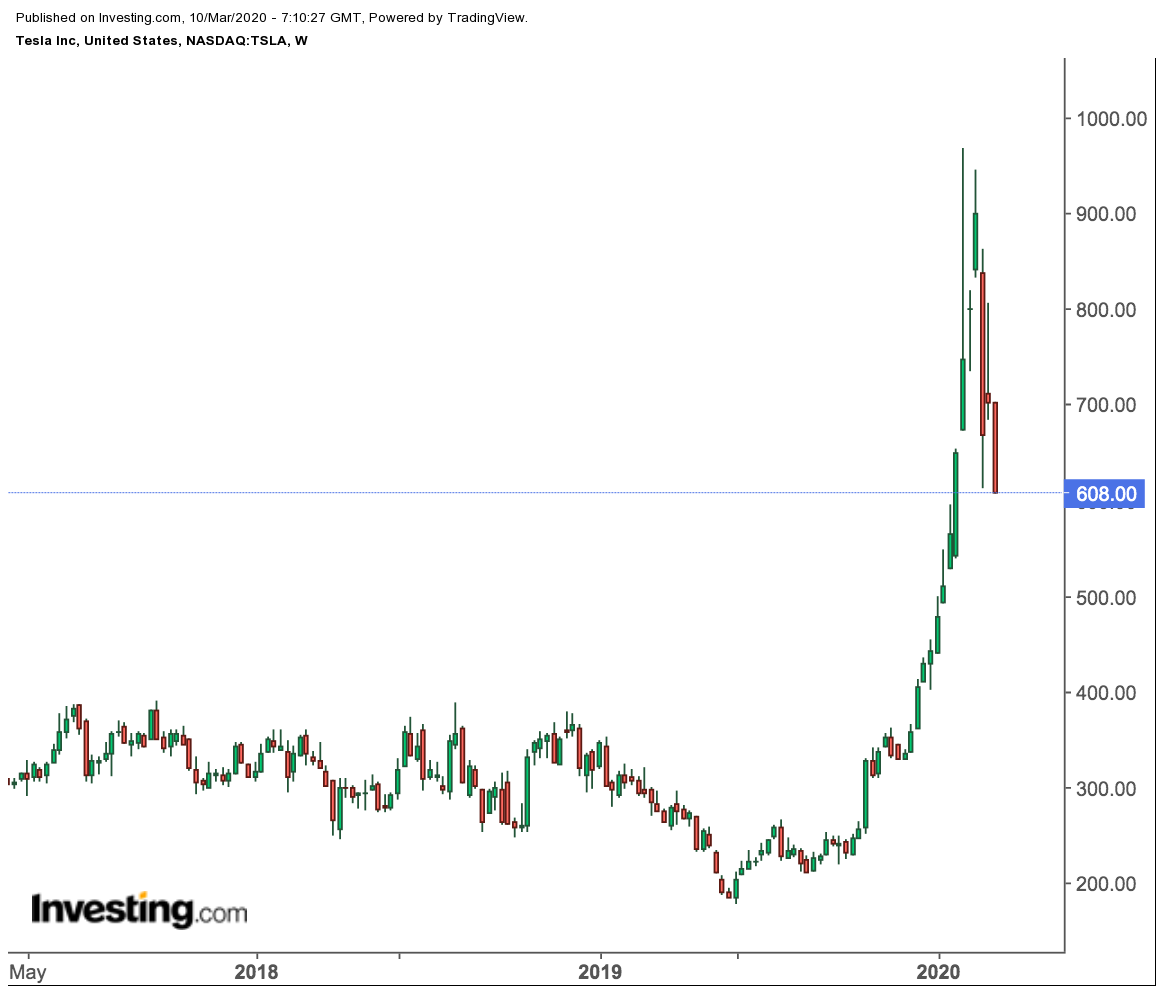Translated by Google:
在今年大規模反彈之後,一直急於跳入併購買特斯拉(納斯達克股票代碼:TSLA)的投資者可能會面臨一個艱難的困境。
這家電動汽車製造商在當前的市場崩盤中暴跌,昨天跌幅超過13%。暴跌使特斯拉陷入了熊市,該股目前的股價已從歷史高位608美元上漲了37%。

特斯拉每週價格走勢圖
但是特斯拉的長期股東沒有太多可抱怨的。儘管經過了大幅調整,但在過去六個月中上漲了約280%之後,在冠狀病毒風險加劇的情況下,在更廣泛的崩潰打擊市場之前,該股在2月初已升至968美元左右。即使在目前的低迷之後,該股仍以超過過去六個月167%的漲幅超過標普500的每隻股票。
但是,隨著市場現在迅速崩潰,特斯拉愛好者可能很難抵制在逢低買入這一表現最好的股票的衝動。但是我們建議謹慎:這種下行趨勢還有更大的運行空間,在這個瞬息萬變的宏觀環境中,這家汽車製造商存在很多隱患。
Pimco的若阿希姆·費爾斯(Joachim Fels)認為,由于冠狀病毒的爆發抑制了供需雙方,因此美國和歐洲在2020年上半年面臨技術衰退的“明顯可能性” 。
太平洋投資管理公司(Pacific Investment Management Co.)全球首席經濟顧問費爾斯(Fels)在給客戶的報告中寫道:“對經濟而言,最壞的情況仍將在未來幾個月內出現。”旅遊相關服務市場。
特斯拉的增長受到威脅
公牛隊今年在特斯拉的支持下反彈,當時創始人兼首席執行官埃隆·馬斯克(Elon Musk)經過多年的過度承諾和供不應求後成功扭轉了困境。該公司超越了分析師對第四季度的收入預期,並加快了新Model Y跨界車的推出。
同樣,特斯拉上海工廠的建成以及該公司成功超越其雄心勃勃的年度銷售360,000輛汽車目標的成功,也有力地表明,如果特斯拉繼續實現其目標,它將迅速成為有意義的行業參與者。
但是,這種樂觀的態勢現在正受到中國乃至全球致命病毒的影響的嚴重威脅,這正在破壞供應線並增加經濟衰退的風險。中國的放緩是特斯拉麵臨的主要挑戰,特別是因為該公司增長軌蹟的很大一部分取決於該國,而該國是電動汽車的主要全球市場之一。
由於對這種病毒的擔憂使購物者望而卻步,中國2月份的汽車銷量創下了月度最大跌幅。根據中國乘用車協會上週發布的初步數據,上個月收據下降了80%。
在需求方面,目前尚不清楚當燃油成本急劇下降時,客戶將如何選擇購買新車。根據CNBC的報告,從歷史上看,當原油和天然氣價格下降時,電動汽車和太陽能裝置的銷售就會放緩。特斯拉的目標是今年銷售50萬輛汽車。一些分析人士說,這個目標現在可能難以實現。
Wedbush Securities的Dan Ives在周一給投資者的一份報告中寫道:“中國的供應鏈問題仍然揮之不去。” “鑑於中國和歐洲的冠狀病毒爆發令需求懸而未決,我們認為特斯拉很難達到1季度單位需求水平,而華爾街目前正在考慮這一動態。”
隨著政府取消對替代能源汽車的補貼,中國的電動汽車銷量在過去幾個季度一直在疲軟。中國汽車市場增速放緩,取消了對特斯拉買家的美國稅收抵免以及馬斯克兌現諾言的風險再次成為使該股未來走勢不確定的主要障礙。
投資者還應該注意,甚至在當前的拋售之前,許多分析師就特斯拉股票泡沫發出警告,指出該股票具有高度投機性的估值。分析師平均預期特斯拉未來12個月的目標價為500美元。
底線
毫無疑問,在提高產量並在中國建立工廠之後,特斯拉重回正軌,這可能證明該公司的長期盈利能力發生了改變。
但是,這家汽車製造商從未經歷過可能引發新車需求急劇萎縮的衰退。考慮到這些不確定因素,我們仍然發現在大規模拋售當中購買特斯拉股票的風險。
但是,這家汽車製造商從未經歷過可能引發新車需求急劇萎縮的衰退。考慮到這些不確定因素,我們仍然發現在大規模拋售當中購買特斯拉股票的風險。
Investors who've been waiting eagerly to jump in and buy Tesla (NASDAQ:TSLA) on the first major dip after its massive rally this year, could be facing a difficult dilemma right now.
The electric carmaker is plummeting in the current market crash,
falling more than 13% yesterday. That plunge has pushed Tesla deep into
bear territory, with the stock now trading 37% from its record high, at
$608.However, with markets now rapidly unraveling, Tesla lovers may find it hard to resist the urge to buy this top-performing stock on the dip. But we advise caution: this move to the downside has more room to run and there are many risks lurking for the carmaker in this fast changing macro environment.
The U.S. and Europe face the “distinct possibility” of a technical recession in the first half of 2020 as the coronavirus outbreak dampens both demand and supply, driving investors to safe havens, according to Pimco’s Joachim Fels.
“The worst for the economy is still to come over the next several months,” Fels, global chief economic adviser at Pacific Investment Management Co., wrote in a note to clients, which also cited concerns including a slump in China’s manufacturing and a weaker market for travel-related services.
Tesla’s Growth Under Threat
Bulls rallied behind Tesla this year, when founder and CEO Elon Musk, after years of over-promising and under-delivering, successfully turned a corner. The company beat analysts’ revenue estimates for 4Q and accelerated the introduction of the new Model Y crossover.As well, the completion of its Shanghai factory and the company's success in exceeding its ambitious goal of selling 360,000 vehicles for the year also offered a powerful signal that Tesla could rapidly become a meaningful industry player if it continues to meet its targets.
But that upbeat scenario is now under serious threat from the impact of the deadly virus in China and globally, which is disrupting supply lines and increasing the risk of a recession. The slowdown in China is a major challenge for Tesla in particular because a significant proportion of the company’s growth trajectory is dependent on that country, one of the major global markets for electric cars.
Car sales in China saw the biggest monthly plunge on record in February as fear of the virus kept shoppers away. Receipts fell 80% last month, according to preliminary numbers from the China Passenger Car Association released last week.
On the demand side, it’s not clear how customers will make their choices about buying a new car when the cost of fuel is falling sharply. Historically, when crude oil and gas prices decline, electric vehicle sales — and solar installations — slow down, according to a report carried by CNBC. Tesla aims to sell 500,000 vehicles this year. This target may now prove hard to meet, some analysts say.
“Supply chain issues in China remain a lingering worry,” Wedbush Securities’ Dan Ives wrote, in a note to investors on Monday. “Given the demand overhang from the coronavirus outbreak in China as well as Europe we believe that 1Q unit demand levels will be difficult to hit for Tesla and is a dynamic currently being factored by the Street.”
Electric vehicle sales have been weakening over the past several quarters in China as the government rolls back subsidies on alternative energy vehicles. A slowing car market in China, the elimination of U.S. tax credits for Tesla buyers and the risk of Musk falling short again on his promises are some of the major obstacles that make the stock’s future path uncertain.
Investors should also note that even before the current sell-off, many analysts were warning about the bubble in Tesla’s stock, pointing to the stock’s highly speculative valuation. Analysts on average have a price target of about $500 for Tesla for the next 12 months.
Bottom Line
There is little doubt that Tesla is back on track after ramping up its production and building a factory in China that could prove a game-changer for the company’s long-term profitability.
But the automaker has never before gone through a recession that could trigger a sharp contraction in demand for new cars. Given these uncertainties, we still find it risky to buy Tesla shares in the middle of this massive sell-off.
沒有留言:
張貼留言